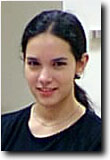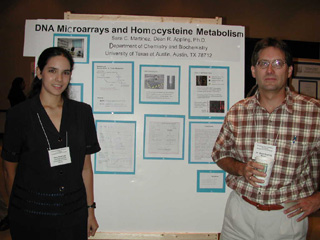What's New?
The 1999-2000 Beckman Scholars: Sara Cecilia West, MD/PhD (nee Martinez)
| Faculty Mentor: Professor Dean R. Appling Length of term: Fall 99, Spring 00, Summer 00; Summer 99 was spent in the SMART program at Baylor College of Medicine. Honors & Awards:University Honors (Spring 99, Fall 99); Dean's Honored Graduate (Spring 00); Deans Scholars Program (Fall 99 — Spring 00); University Research Fellowship (1999, 2000); University Co-Op Award; Robert Smith and Lyle Pickett Davis Scholarship (2000); Ruth L. Kirschstein National Research Service Award (NRSA) Pre-doctoral fellowship awarded through the NIH/NIDDK (2003-5); Cardiology Fellowship (2010+) Publications: Glucose Regulates Foxo1 through Insulin Receptor Signaling in the Pancreatic Islet Beta-Cell S.C. Martinez, C. Cras-Méneur, E. Bernal-Mizrachi, and M.A. Permutt, Diabetes 2006 Jun;55(6):1581-1591.; S.C. Martinez, C. Cras-Méneur, E. Bernal-Mizrachi, and M.A. Permutt, Diabetes 2006 Jun; 55(6): 1581-1591. Martinez SC, Tanabe K, Cras-Méneur C, Abumrad NA, Bernal- Mizrachi E, Permutt MA, Diabetes. 2008 Apr;57(4):846-59. Epub 2008 Jan 3. Tanabe K, et al. PLoS Biol. 2008 Feb;6(2):e37. Tanabe, K. et al, PLoS One. 2011 Apr 26;6(4):e18146. S.C. Martinez et al, submitted to J. Heart Lung Transplantation (2012). Where is she now? Graduated with Bachelor of Science in Biochemistry with High Honors, May 2000. Sara completed the MD/PhD programme at Washington University in 2008, and is currently a Cardiology physician scientist at Washington University/Barnes Jewish Hospital in St Louis. How can I contact her?scmwest at gmail.com |  |
Beckman research project in the Appling group:
DNA microarrays and homocysteine metabolism
My research was aimed at understanding the role of homocysteine in folate metabolism, and its phenotypic and genomic effects on the eukaryotic cell, using the yeast Saccharomyces cerevisiae as a model organism. Endogenous homocysteine is involved in folate and methionine metabolism as an intermediate reactive compound. Homocysteine is an essential intermediate in the methyl group metabolism, yet it is toxic. There is evidence of a correlation between higher than normal levels of homocysteine in the plasma levels and increased levels of vascular diseases such as atherosclerosis and thrombosis. The effects of excess exogenous and endogenous homocysteine concentrations on the eukaryotic model, yeast, have yet to be fully understood.
Intracellular homocysteine and methionine concentrations can be manipulated in mutant yeast cells lacking genes that encode enzymes essential to the methylation step of homocysteine for methionine synthesis. Such metabolic mutant yeast strains had already been developed in our research group. An investigation of homocysteine's role in metabolism was performed using these genetic mutants by analyzing the growth effects from excess exogenous and endogenous concentrations of homocysteine using comparative growth curve analysis.
We found that there is remarkable growth sensitivity in wild-type yeast to exogenous homocysteine, yet no change in growth for a methionine-auxotrophic strain (Dmet6, methionine synthase) with a known high intracellular concentration. With no observable phenotype between a wild type and a mutant strain other than one auxotrophy, I planned and completed the construction of a DNA Microarray facility for the Institute of Cellular and Molecular Biology at the university. The microarray-scanner database approach is being used to compare genome response patterns from changes in the yeast expression due to metabolic mutants or a change in growth conditions. Results from my microarray experiments are pending analysis.
I can only assume that the genes responsible for alleviating intracellular homocysteine levels in the genetic mutant and cells exposed to added homocysteine would be upregulated. These genes include a methyl-tetrahydrofolate reductase and genes responsible in cysteine production. Future experiments to be completed in the Appling Lab using the microarray technology will be entered into a database; software exists which will compare experiments together and indicate which genes show similar patterns of expression/non-expression. This technology, in conjunction with growth curve analysis and classical genetics, yields the opportunity to piece together uncharacterized genes and gain insight into a yeast cell’s complete metabolic control mechanisms in response to excess extracellular or intracellular homocysteine concentrations. Following this analysis, we do foresee publishing this work in a journal such as the Journal of Biological Chemistry. In addition, we hope to characterize and publish future research on genes with no prior apparent or assigned function.

Created and maintained by Ruth Shear. Comments to author at DrRuth@mail.utexas.edu
Created Mon Mar 22nd 1999. Last modified Mon, Mar 16, 2015.